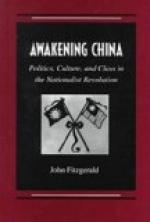In the confused strife of North and South the preponderance is greatly on the side of the Tartars. The pendulum of destiny then begins to swing in the other direction. Yan Kien, a Chinese general in the service of a Tartar principality, took advantage of their divisions to rally a strong body of his countrymen by whose aid he cut them off in detail and set up the Sui dynasty, The Tartars have always made use of Chinese in the invasion of China; and if the Chinese were always faithful to their own country no invader would succeed in conquering them.
Though the Sui dynasty lasted less than thirty years (589-618, three reigns), it makes a conspicuous figure on account of two events: (1) a victorious expedition in the north which reached the borders of [Page 118] Turkestan, and (2) the opening of canals between the Yellow River and the Yang-tse Kiang. The latter enterprise only hastened the fall of the house. It was effected by forced labour; and the discontented people were made to believe, as their historians continue to assert, that its chief object was to enable a luxurious emperor to display his grandeur to the people of many provinces. We shall see how the extension of those canals precipitated the overthrow of the Mongols as we have already seen how the completion of the Great Wall caused the downfall of the house of Ts’in.
Yang-ti, the second emperor of the Sui dynasty, though not wanting in energy, is notorious for his excesses in display and debauch. He is reported to have hastened his accession to the throne by the murder of his father. A peaceful end to such a reign would have been out of keeping with the course of human events. Li Yuen, one of his generals, rose against him, and he was assassinated in Nanking.
By wisdom and courage Li Yuen succeeded in setting up a new dynasty which he called T’ang (618 A. D.): After a long period of unrest, it brought to the distracted provinces an era of unwonted prosperity; it held the field for nearly three hundred years, and surpassed all its predecessors in splendour.
[Page 119] CHAPTER XXII
THE T’ANG DYNASTY, 618-907 A. D.
(20 Emperors)
An Augustan Age—A Pair of Poets—The Coming of Christianity—The Empress Wu—System of Examinations
I have seen a river plunge into a chasm and disappear. After a subterranean course of many miles it rose to the surface fuller, stronger than before. No man saw from whence it drew its increment of force, but the fact was undeniable. This is just what took place in China at this epoch.
It is comforting to know that during those centuries of turmoil the Chinese were not wholly engrossed with war and rapine. The T’ang dynasty is conspicuously the Augustan Age. Literature reappears in a more perfect form than under the preceding reigns. The prose writers of that period are to the present day studied as models of composition, which cannot be affirmed of the writers of any earlier epoch. Poetry, too, shone forth with dazzling splendour. A galaxy of poets made their appearance, among whom two particular stars were Tufu and Lipai, the Dryden and Pope of Chinese literature.




